Continuous Control Set Predictive Control with Affine Registration Technique for Permanent Magnet Synchronous Motor Drive
Abstract
1. Introduction
2. Materials and Methods
2.1. Conventional CCS-MPC Method
2.2. Defect of Conventional Method
2.3. Proposed Image Registration Technique-Based Predictive Control Solution
2.3.1. Affine Registration Algorithm
2.3.2. Improved CCS-MPC Solution
3. Results
4. Discussion
5. Conclusions
Author Contributions
Funding
Data Availability Statement
Conflicts of Interest
References
- Jabbour, N.; Mademlis, C. Online parameters estimation and autotuning of a discrete-time model predictive speed controller for induction motor drives. IEEE Trans. Power Electron. 2019, 34, 1548–1559. [Google Scholar] [CrossRef]
- Tu, W.; Luo, G.; Chen, Z.; Liu, C.; Cui, L. FPGA Implementation of Predictive Cascaded Speed and Current Control of PMSM Drives With Two-Time-Scale Optimization. IEEE Trans. Ind. Informat. 2019, 15, 5276–5288. [Google Scholar] [CrossRef]
- Guo, T.; Sun, Z.; Wang, X.; Li, S.; Zhang, K. A Simple Current-Constrained Controller for Permanent-Magnet Synchronous Motor. IEEE Trans. Ind. Informat. 2019, 15, 1486–1495. [Google Scholar] [CrossRef]
- Bolognani, S.; Peretti, L.; Zigliotto, M. Design and Implementation of Model Predictive Control for Electrical Motor Drives. IEEE Trans. Ind. Electron. 2009, 56, 1925–1936. [Google Scholar] [CrossRef]
- Liu, X.; Wang, J.; Gao, X.; Tian, W.; Zhou, L.; Rodriguez, J.; Kennel, R. Continuous Control Set Predictive Speed Control of SPMSM Drives With Short Prediction Horizon. IEEE Trans. Power Electron. 2022, 37, 10166–10177. [Google Scholar] [CrossRef]
- Nguyen, H.T.; Jung, J.-W. Finite Control Set Model Predictive Control to Guarantee Stability and Robustness for Surface-Mounted PM Synchronous Motors. IEEE Trans. Ind. Electron. 2018, 65, 8510–8519. [Google Scholar] [CrossRef]
- Jung, J.; Leu, V.Q.; Do, T.D.; Kim, E.; Choi, H.H. Adaptive PID speed control design for permanent magnet synchronous motor drives. IEEE Trans. Power Electron. 2015, 30, 900–908. [Google Scholar] [CrossRef]
- Cai, R.; Zheng, R.; Liu, M.; Li, M. Robust Control of PMSM Using Geometric Model Reduction and μ-Synthesis. IEEE Trans. Ind. Electron. 2018, 65, 498–509. [Google Scholar] [CrossRef]
- Zhou, Y.; Li, H.; Liu, R.; Mao, J. Continuous Voltage Vector Model-Free Predictive Current Control of Surface Mounted Permanent Magnet Synchronous Motor. IEEE Trans. Ener. Conv. 2019, 30, 899–908. [Google Scholar] [CrossRef]
- Wang, B.; Chen, X.; Yu, Y.; Wang, G.; Xu, D. Robust predictive current control with online disturbance estimation for induction machine drives. IEEE Trans. Power Electron. 2017, 32, 4663–4674. [Google Scholar] [CrossRef]
- Xia, C.; Wang, M.; Song, Z.; Liu, T. Robust model predictive current control of three-phase voltage source PWM rectifier with online disturbance observation. IEEE Trans. Ind. Informat. 2012, 8, 459–471. [Google Scholar] [CrossRef]
- Zhang, X.; Hou, B.; Mei, Y. Deadbeat predictive current control of permanent-magnet synchronous motors with stator current and disturbance observer. IEEE Trans. Power Electron. 2017, 32, 3818–3834. [Google Scholar] [CrossRef]
- Chen, Y.; Liu, C.; Liu, S.; Song, Z. A new cascaded adaptive deadbeat control method for PMSM drive. IEEE Trans. Ind. Electron. 2023, 70, 3384–3393. [Google Scholar] [CrossRef]
- Gong, C.; Hu, Y.; Gao, J.; Wang, Y.; Yan, L. An improved delay-suppressed sliding-mode observer for sensorless vector-controlled PMSM. IEEE Trans. Ind. Electron. 2020, 67, 5913–5923. [Google Scholar] [CrossRef]
- Tinazzi, F.; Carlet, P.G.; Bolognani, S.; Zigliotto, M. Motor parameter free predictive current control of synchronous motors by recursive least square self-commissioning model. IEEE Trans. Ind. Electron. 2020, 67, 9093–9100. [Google Scholar] [CrossRef]
- Yang, M.; Lang, X.; Long, J.; Xu, D. Flux immunity robust predictive current control with incremental model and extended state observer for PMSM drive. IEEE Trans. Power Electron. 2017, 32, 9267–9279. [Google Scholar] [CrossRef]
- Mao, J.; Li, H.; Yang, L.; Zhang, H.; Liu, L.; Wang, X.; Tao, J. Non-cascaded model-free predictive speed control of SMPMSM drive system. IEEE Trans. Ener. Conv. 2022, 37, 153–162. [Google Scholar] [CrossRef]
- Zhang, Y.; Jiang, T.; Jiao, J. Model-free predictive current control of a DFIG using an ultra-local model for grid synchronization and power regulation. IEEE Trans. Ener. Conv. 2020, 35, 2269–2280. [Google Scholar] [CrossRef]
- Safaei, A.; Mahyuddin, M.N. Adaptive Model-Free Control Based on an Ultra-Local Model With Model-Free Parameter Estimations for a Generic SISO System. IEEE Access 2018, 6, 4266–4275. [Google Scholar] [CrossRef]
- Li, X.; Wang, Y.; Guo, X.; Cui, X.; Zhang, S.; Li, Y. An Improved Model-Free Current Predictive Control Method for SPMSM Drives. IEEE Access 2021, 9, 134672–134681. [Google Scholar] [CrossRef]
- Karamanakos, P.; Geyer, T. Model Predictive Torque and Flux Control Minimizing Current Distortions. IEEE Trans. Power Electron. 2019, 34, 2007–2012. [Google Scholar] [CrossRef]
- Ai, Q.; Ke, D.; Zuo, J.; Meng, W.; Liu, Q.; Zhang, Z.; Xie, S. High-Order Model-Free Adaptive Iterative Learning Control of Pneumatic Artificial Muscle With Enhanced Convergence. IEEE Trans. Ind. Electron. 2020, 67, 9548–9559. [Google Scholar] [CrossRef]
- Zhao, L.; He, W.; Lv, F. Model-Free Adaptive Control for Parafoil Systems Based on the Iterative Feedback Tuning Method. IEEE Access 2021, 9, 35900–35914. [Google Scholar] [CrossRef]
- Liao, S.; Chung, A. Nonrigid Brain MR Image Registration Using Uniform Spherical Region Descriptor. IEEE Trans. Image Process. 2021, 21, 157–169. [Google Scholar] [CrossRef] [PubMed][Green Version]
- Chen, S.; Guo, Q.; Leung, H.; Bossé, É. A Maximum Likelihood Approach to Joint Image Registration and Fusion. IEEE Trans. Image Process. 2011, 20, 1363–1372. [Google Scholar] [CrossRef]
- Woo, J.; Stone, M.; Prince, J.L. Multimodal Registration via Mutual Information Incorporating Geometric and Spatial Context. IEEE Trans. Image Process. 2015, 24, 757–769. [Google Scholar] [CrossRef]
- Zosso, D.; Bresson, X.; Thiran, J. Geodesic Active Fields—A Geometric Framework for Image Registration. IEEE Trans. Image Process. 2011, 20, 1300–1312. [Google Scholar] [CrossRef]
- Cao, S.; Shen, H.; Chen, S.; Li, C. Boosting Structure Consistency for Multispectral and Multimodal Image Registration. IEEE Trans. Image Process. 2020, 29, 5147–5162. [Google Scholar] [CrossRef]
- Ho, J.; Peter, A.; Rangarajan, A.; Yang, M. An algebraic approach to affine registration of point sets. In Proceedings of the 2009 IEEE 12th International Conference on Computer Vision, Kyoto, Japan, 29 September–2 October 2009; pp. 1335–1340. [Google Scholar]
- Li, H.; Nie, Z.; Belie, F.D. Image Registration Technique to Improve a Self-Sensing Estimation for Model Predictive Controlled Interior PMSM Drives. IEEE Trans. Ind. Electron. 2021, 68, 11941–11953. [Google Scholar] [CrossRef]
- Fliess, M.; Sira-Ramirez, H. Closed-loop parametric identification for continuous-time linear systems via new algebraic techniques. In Identification of Continuous-Time Models from Sampled Data; Advances in Industrial Control; Springer: London, UK, 2008. [Google Scholar]
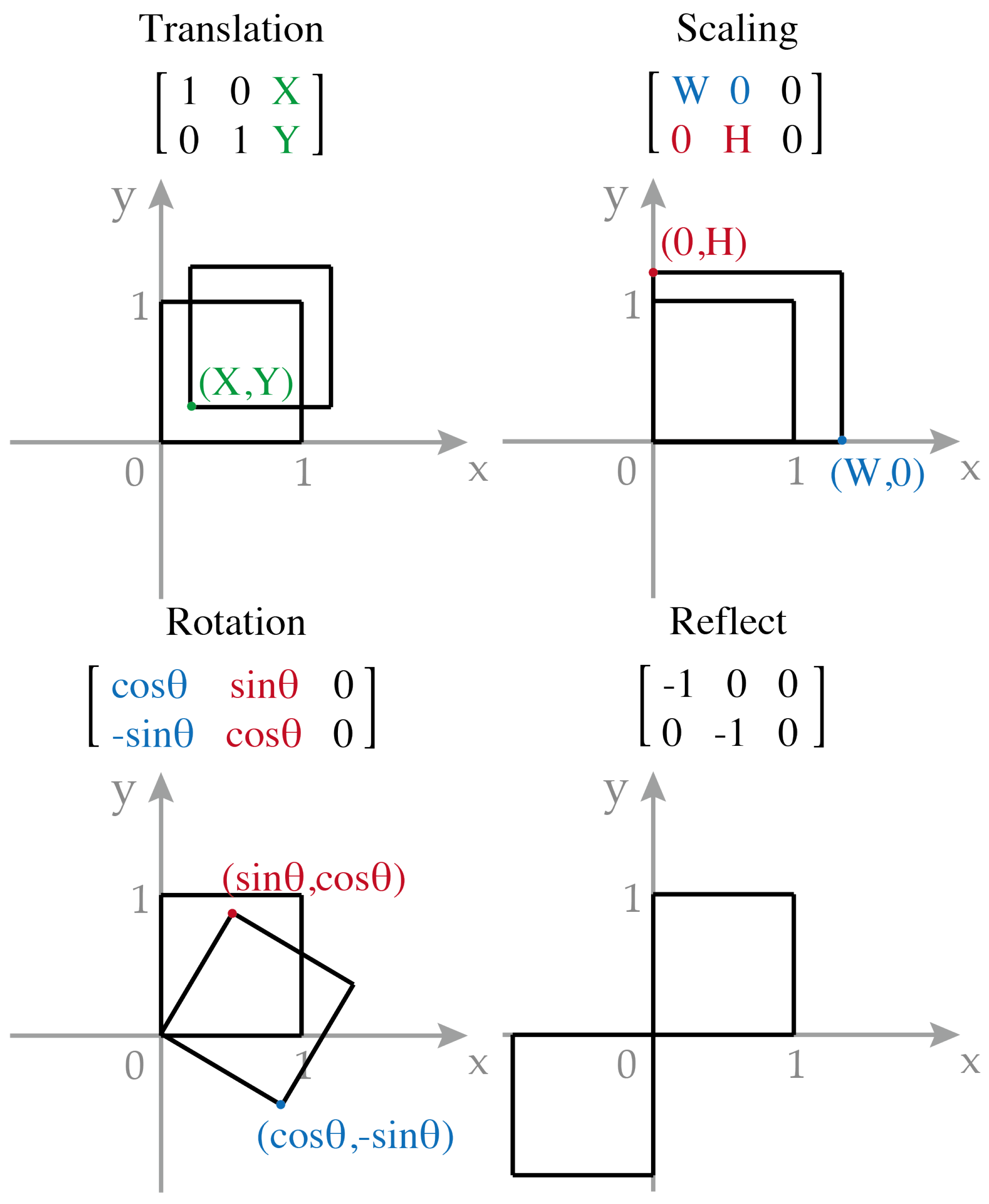


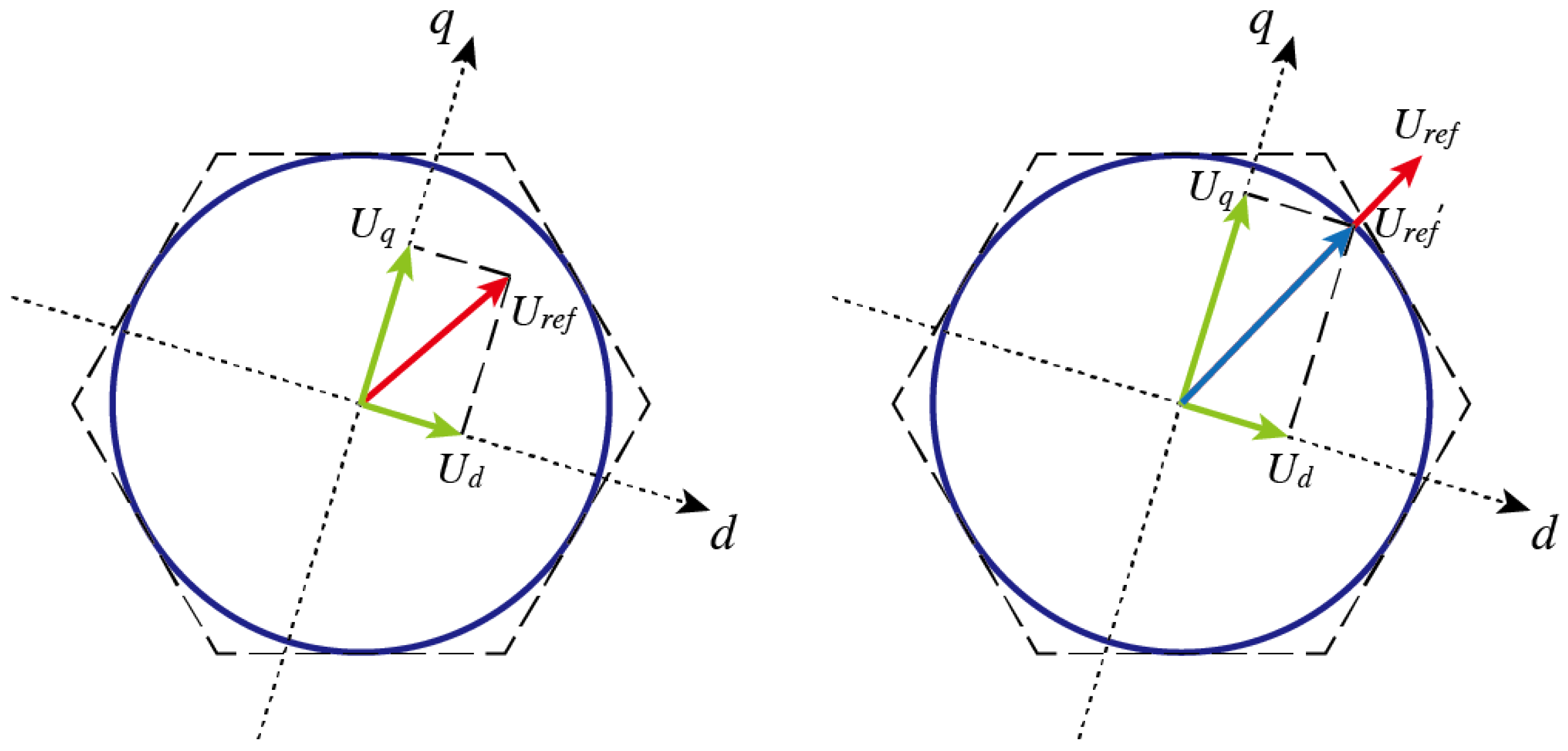

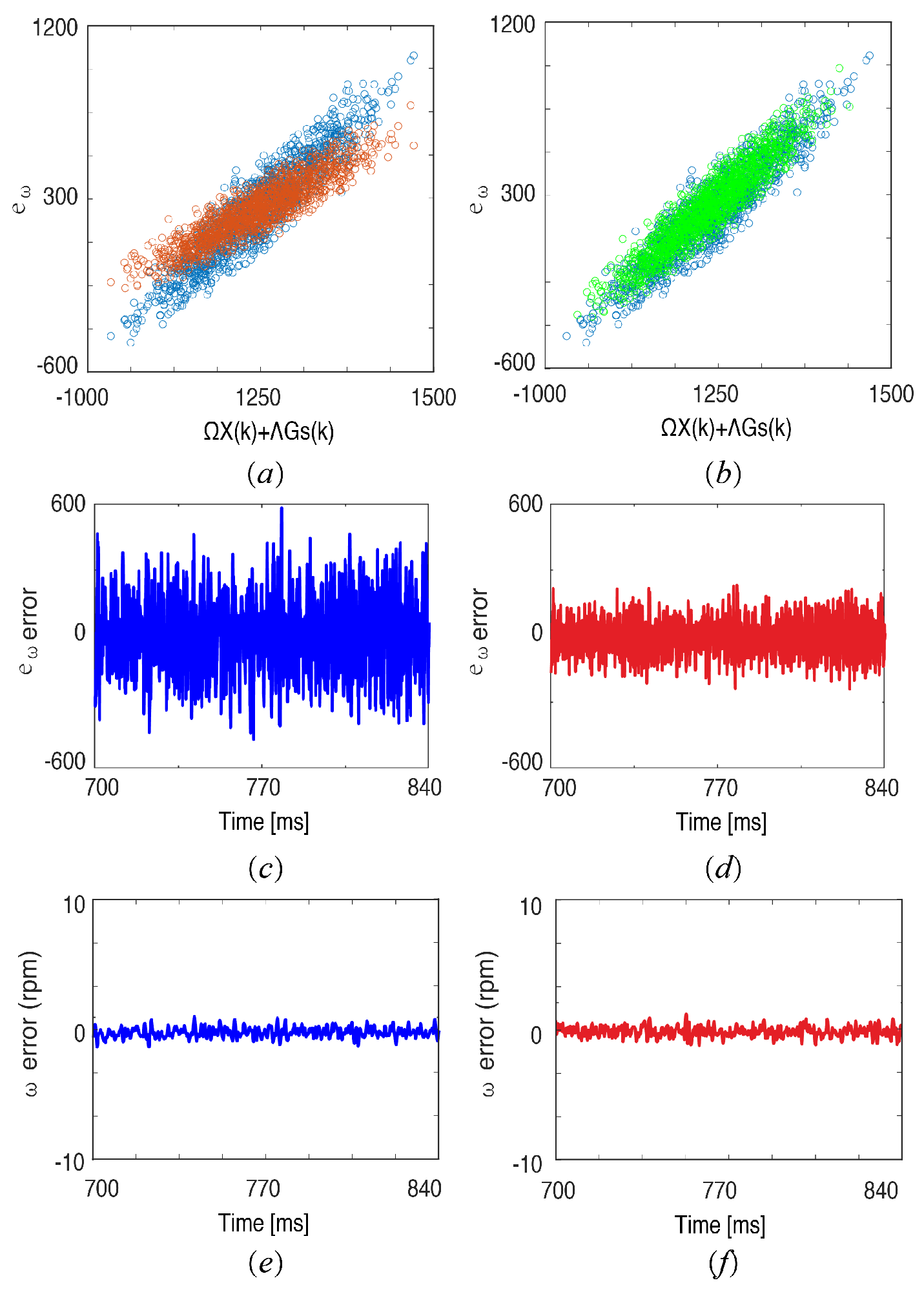
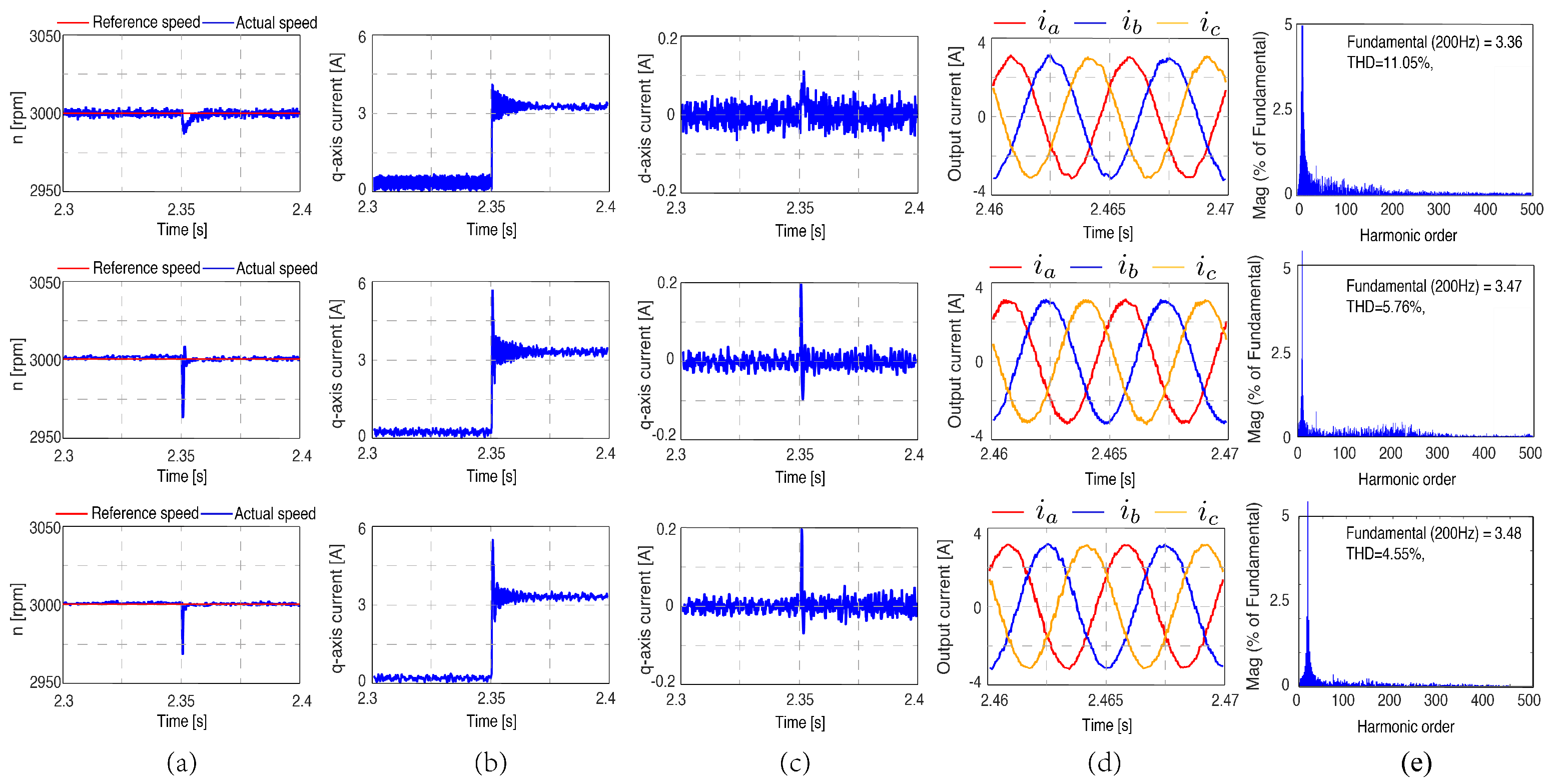

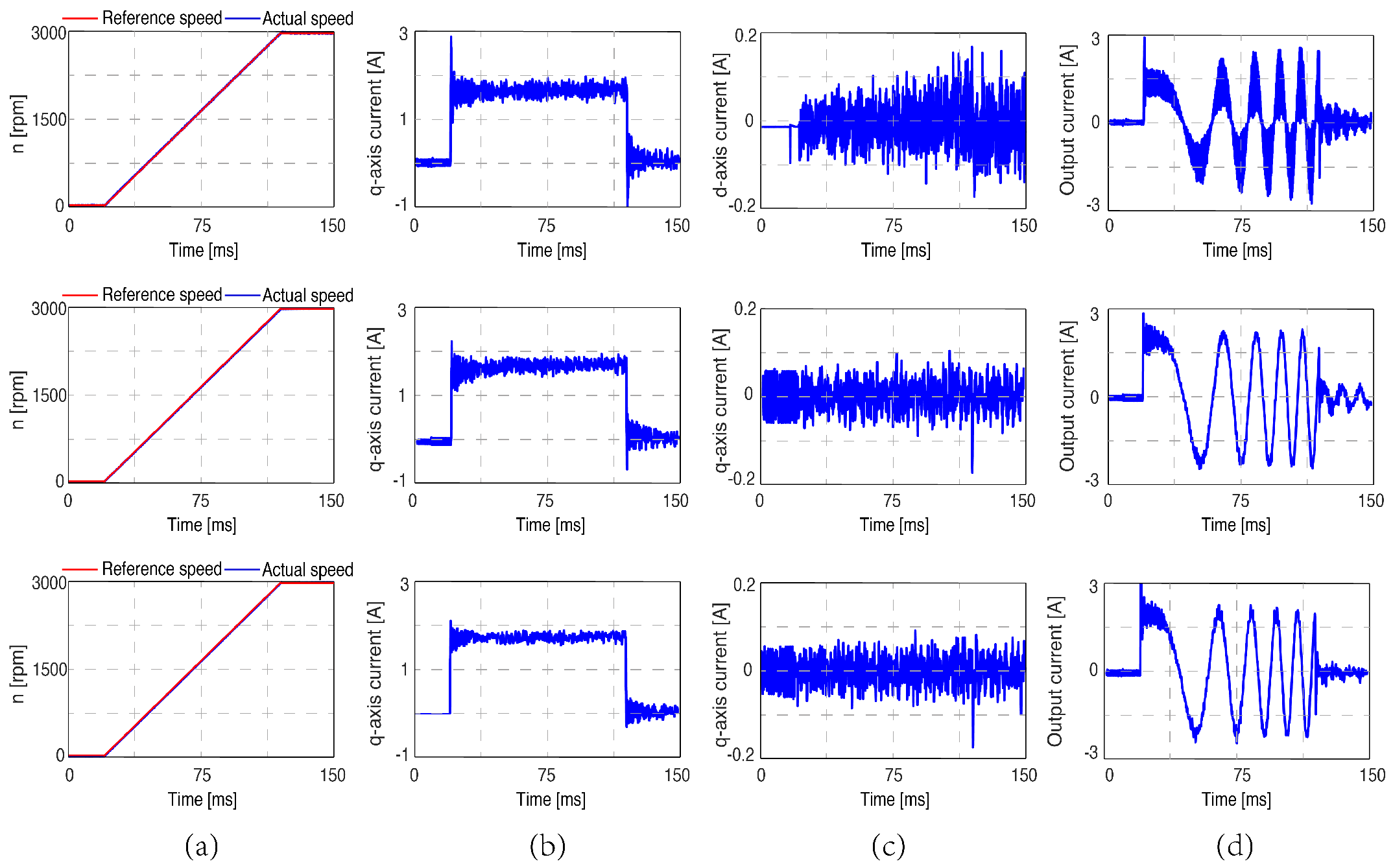
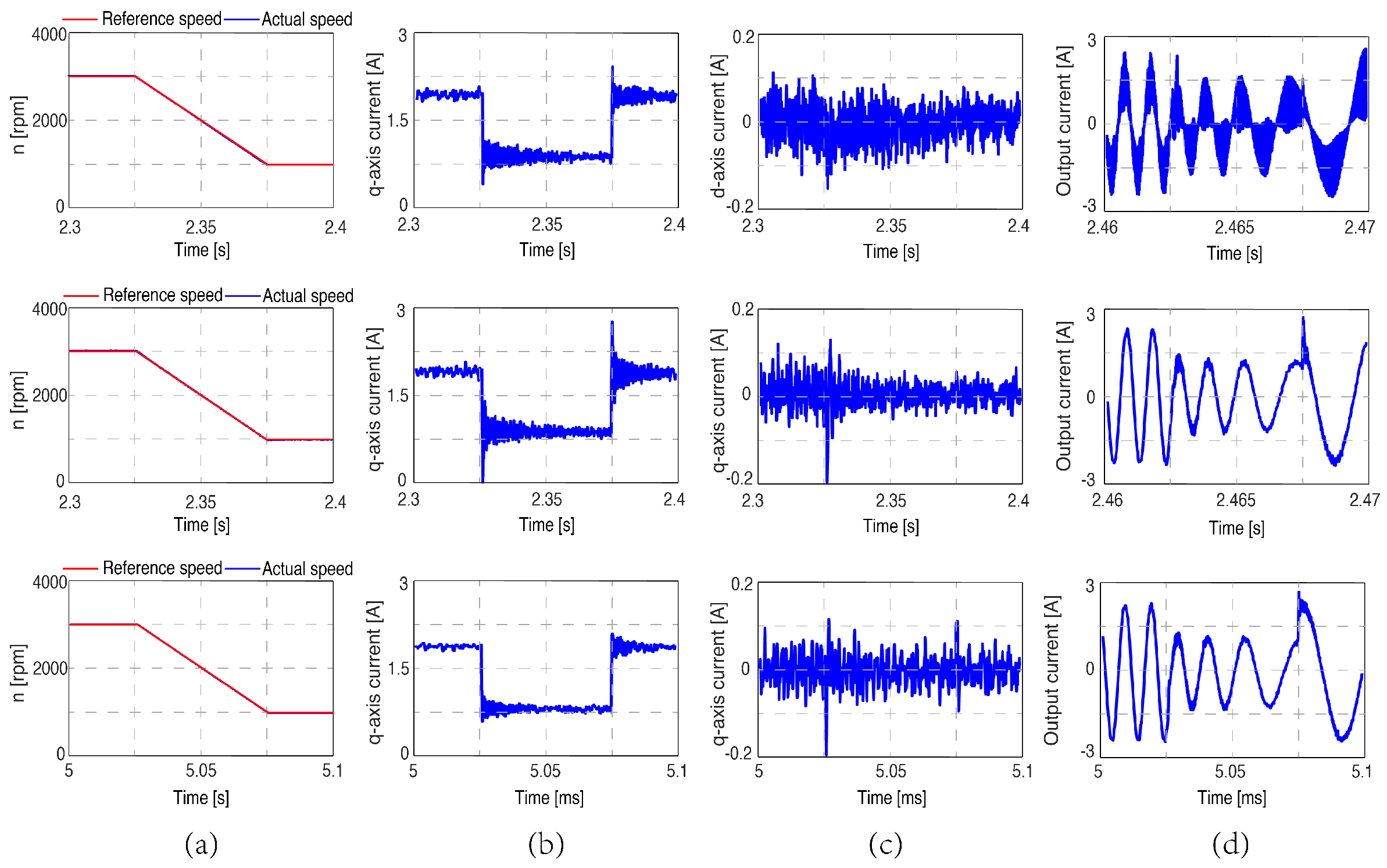
| Parameter | Value |
|---|---|
| Stator resistance | 0.43 Ohm |
| Stator inductance | 6.8 mH |
| Rotor flux linkage | 0.127 Wb |
| Rated current I | 6.0 A |
| Rated voltage U | 300 V |
| Rated speed | 3000 rpm |
| Pole pair number P | 4 |
| Total rotor inertia J | 0.3 g· m2 |
| 800 | |
| 0.4 |
| Control Scheme | MPC (4) | MFPC (16) | Proposed (27) | |||
|---|---|---|---|---|---|---|
| Operating Condition | 600 rpm | 3000 rpm | 600 rpm | 3000 rpm | 600 rpm | 3000 rpm |
| Speed settling time (ms) | 19.0 | 19.5 | 3.4 | 3.5 | 2.8 | 2.8 |
| Speed drop (rpm) | 26.5 | 27.3 | 25.1 | 25.3 | 23.4 | 23.2 |
| overshoot (A) | 0.86 | 0.84 | 2.51 | 2.74 | 2.18 | 2.43 |
| THD (%) | 5.84 | 11.05 | 4.52 | 5.76 | 4.32 | 4.55 |
Disclaimer/Publisher’s Note: The statements, opinions and data contained in all publications are solely those of the individual author(s) and contributor(s) and not of MDPI and/or the editor(s). MDPI and/or the editor(s) disclaim responsibility for any injury to people or property resulting from any ideas, methods, instructions or products referred to in the content. |
© 2024 by the authors. Licensee MDPI, Basel, Switzerland. This article is an open access article distributed under the terms and conditions of the Creative Commons Attribution (CC BY) license (https://creativecommons.org/licenses/by/4.0/).
Share and Cite
Zhao, W.; Ye, J.; Yang, M. Continuous Control Set Predictive Control with Affine Registration Technique for Permanent Magnet Synchronous Motor Drive. Energies 2024, 17, 4706. https://doi.org/10.3390/en17184706
Zhao W, Ye J, Yang M. Continuous Control Set Predictive Control with Affine Registration Technique for Permanent Magnet Synchronous Motor Drive. Energies. 2024; 17(18):4706. https://doi.org/10.3390/en17184706
Chicago/Turabian StyleZhao, Wentao, Jianxiong Ye, and Min Yang. 2024. "Continuous Control Set Predictive Control with Affine Registration Technique for Permanent Magnet Synchronous Motor Drive" Energies 17, no. 18: 4706. https://doi.org/10.3390/en17184706
APA StyleZhao, W., Ye, J., & Yang, M. (2024). Continuous Control Set Predictive Control with Affine Registration Technique for Permanent Magnet Synchronous Motor Drive. Energies, 17(18), 4706. https://doi.org/10.3390/en17184706






